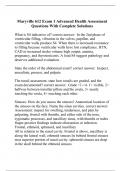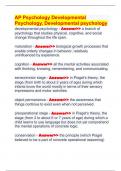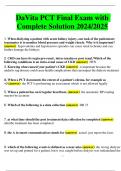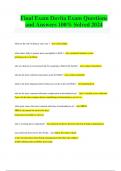Maryville 612 Exam 1 Advanced Health Assessment
Questions With Complete Solutions
What is S4 indicative of? correct answer: In the 2nd phase of
ventricular filling, vibration in the valves, papillae, and
ventricular walls produce S4. When there is increased resistance
to filling because ventricular walls have lost compliance. HTN,
CAD or increased stroke volume high output, anemia,
pregnancy, and thyrotoxicosis. A loud S4 suggest pathology and
deserves additional evaluation.
State the order of the abdominal exam? correct answer: Inspect,
auscultate, percuss, and palpate
The tonsil assessment, state how tonsils are graded, and the
exam documented? correct answer: Grade +1-+4. 1+ visible, 2+
halfway between tonsillar pillars and the uvula, 3+ nearly
touching the uvula, 4+ touching each other.
Sinuses- How do you assess the sinuses? Anatomical location of
the sinuses on the face. Name the sinus cavities. correct answer:
Assessment: inspect for swelling, tenderness, and pain by
palpating, frontal with thumbs, and either side of the nose,
zygomatic processes, and maxillary sinus, with thumbs or index
finger-positive findings indicate obstruction or infection.
Frontal, ethmoid, sphenoid, and maxillary
All in relation to the nasal cavity. Frontal is above, maxillary is
along the lateral wall, ethmoid sinuses lie behind frontal sinuses
near superior portion of nasal cavity, sphenoid sinuses are deep
in the skull behind the ethmoid sinuses.
, Know the oral cancer assessment, screening. correct answer:
Inspecting the oral cavity, have pt lift tongue, move side to side,
up and stick out, palpate with gloved hand.
What is the most common site of oral cancer? correct answer:
Vermilion border of the lips (line that goes around the outside of
the lips).
What are the steps of the hearing exam with the tuning fork?
correct answer: Weber test- used with a tuning fork for you to
compare hearing by bone conduction with that by air
conduction. You're going to strike the tuning fork and you're
going to put that at the top of the patient's head and the ask them
to tell you whether or not there is sound from the vibration both
ears equally or dose it lateralize to the affected side.
Rhinne Test- Assesses and compares patient's ability to hear
both through bone and air conduction. Again, you strike the
tuning fork and you actually place it on the mastoid bone behind
the patients ear one at a time and when the patient can no longer
hear the vibration, you move the tuning fork to place it next to
the ear, laterally to the ear and then ask the patient to tell you
when the sound stops. You're going to compare the air
conduction with the bone conduction and the actual air
conduction is supposed to be more than bone conduction, which
is normal, ac is more than bc.
What do both of the hearing tests meanin reference to length of
sound and fork positions? correct answer: Weber- should hear
vibration bilaterally. Rhinne- 2:1 air to bone, air should be twice
as long.







